-
Introduction
-
What happens when a lead storage battery is charged?
-
How do you charge lead acid batteries?
-
How does lead acid battery work?
-
Conclusion
How is a Lead Storage Battery Recharged-Introduction and Methods
Jan 25, 2021 Pageview:860
Introduction
Lead acid batteries, also known as lead acid batteries, are the oldest types of storage batteries. Batteries are commonly used as energy storage devices. The lead-acid battery was invented in 1859 by the French physicist Gaston Plant. Lead acid batteries are still used in many areas. It is often used in vehicles where batteries can generate high winding currents.
Lead acid batteries are very stable but have a short life span. It is also made from highly toxic materials that are difficult to transport and require a unique method of disposal at end-of-life. The response time is good and the power density of this type of battery depends on the energy conversion technology. Lead acid batteries can receive or transmit energy almost instantly. Lead acid batteries are temperature dependent and need to be serviced to prolong their life. For the expected period.
What happens when a lead storage battery is charged?
Lead acid batteries are secondary because they can be charged, discharged through a load, and then recharged. In a lead acid battery, the anode plate, which is the anode, is made of lead, and the anode plate, which is the cathode, is made of lead dioxide, and this electrode is immersed in a sulfuric acid electrolyte solution. Lead acid batteries are useful because they can store a lot of energy and thus provide high power for a short period of time. When a lead-acid battery is charged, it works as an electrolytic cell, and when a lead-acid battery is discharged, it works as a galvanic cell. When a lead acid battery is charged, the reaction is reversed: the negative electrode becomes the positive electrode, and the positive electrode becomes the negative electrode. Lead acid batteries are usually charged from an external power source. The reaction taking place at the anode during charging is as follows.

How do you charge lead acid batteries?
Lead acid batteries use direct current charging (CCCV). The regulated current increases the connection voltage until the upper limit of the charging voltage is reached. At this point, the current drops due to saturation. Charging times are 12 to 16 hours, and for large stationary batteries 36 to 48 hours. Higher charging current and multi-stage charging method can shorten the charging time to 8-10 hours. Not fully charged. A lead acid battery is slow and cannot charge as quickly as other battery systems. In the CCCV method, lead-acid batteries are charged in three stages:
●DC Charging
●Charging
●Trickle Charging
DC charging takes up most of the charge and approximately half the required charging time. Continuous charging and saturation at low charging current, trickle charging compensates for losses due to the discharge itself.
How does lead acid battery work?
Lead acid batteries are inexpensive, convenient, and work in many rechargeable batteries. They are best known for being used in vehicles that power everything from starts to electronics. Lead acid batteries have many benefits for the automotive industry and for many other uses. It has high current and high voltage, ideal for starting internal combustion engines. Lead acid batteries as a technology are a well-established technology that can be easily manufactured using modern equipment.
The basics work process of lead-acid batteries :The principle of operation of lead-acid batteries and the main components must be considered. A battery consists of a relatively small number of components and basically has four main components.
Positive plate
Coated with lead dioxide paste
Negative plate: made of lead sponge.
Spacer: This is an insulating material between two plates.
All of these ingredients are contained in a plastic container that holds the electrolyte inside and the battery.The entire battery usually consists of several cells connected in series to obtain the required voltage, as each cell can transmit 2.1 volts EMF.
In order for an alkaline lead acid cell to produce a voltage, it must first be charged. The voltage applied to ensure this must be greater than 2.1 volts for current to flow into the cell. If it's less than that, it will really leak out.Once charged, the cell or battery can charge an external circuit which, depending on the depletion of the cell or battery, often takes several hours.
Self-discharge Lead Battery
Lead-acid battery's self-discharge properties are relatively good. At room temperature of 20 ° C, the self-discharge rate is about 3% per month.> Theoretically, a lead-acid battery can be stored for up to 12 months without charging. However, the self-discharge is higher at higher temperatures. Self-emptying increases at 30 ° C and recharging is required after 6 months. If the battery drops below 60% for a period of time, sulfation will occur.
Sulfation is a process that reduces the capacity of the lead-acid battery. With normal use, small sulfate crystals are formed, but this is normal and harmless. With a longer discharge, however, the amorphous lead sulfate turns into a stable crystal and is deposited on the negative plate. This leads to the development of large crystals which reduce the active ingredients in the cells and cause a decrease in capacity in the cells.
Conclusion
The lead acid battery is well installed. It has been in use for over 150 years and is now a staple in the automotive industry. Lead acid batteries have high current capacity, low cost, and are resistant to abuse. This is ideal for many applications. Electric vehicles are now looking to the future with a cleaner energy source. There are no internal combustion engines according to manufacturers and laws. In electric vehicles, lithium-ion technology performs better, is more environmentally friendly, and has characteristics that make electric vehicles more successful. As a result, lead acid batteries tend to be used less frequently.
Leave Message
Hottest Categories
-
Hottest Industry News
-
Latest Industry News










